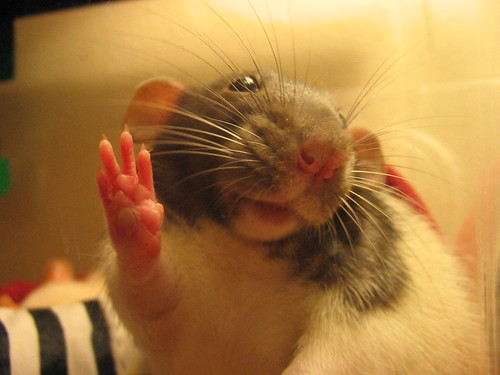Moderate and Severe Caloric Restriction Alter Behavior Differently in Rats
Caloric restriction (CR) is known to increase the lifespan in a variety of species. It is assumed that this increase is largely due to a defense response resulting from low-intensity stress. This beneficial response to mild stress is known as "hormesis".
One theory that fits well with hormesis is that when the organism senses a scarcity of food, it begins directing resources into maintenance instead of reproduction, so that it will survive the scarcity and reproduce later. This "maintenance program" then results in several health benefits that ultimately manifest themselves as longer lifespan.
The effects of CR on many of the biological markers of health are pretty well understood. Less known, however, are the psychological effects of CR, especially when CR is begun in adulthood instead of childhood. To see how a decreased energy intake affects behaviour, Govic et al. put male rats on calorie-restricted diets and observed their social behaviour with other male rats.
Moderate (25%) CR vs. severe (50%) CR
The study included 32 adult male Wistar rats as experimental subjects and 10-week-old ad libitum fed rats as the stimulus animals in the social interaction test. The experimental rats were put on one of three diets: ad libitum (the control group), 25% calorie restriction (moderate CR), or 50% calorie restriction (severe CR).
As would be expected, the CR rats weighed significantly less than the control rats. The 25% CR rats gained less weight than the control rats, while the 50% CR rats lost weight during the course of the study.
For the social interaction experiment, each rat was placed into an arena with an unfamiliar male of the same size. The social behavioral elements that were measured were time until contact, duration of time spent in social exploration, and walking over the other rat. Non-social behaviors included time spent self-grooming and the frequency of environmental assesment as measured by rearing.
Effects on social behavior
Both groups on calorie restriction initiated social contact with the other rat sooner than the control group (Fig. 1A) . The rats in the control group took about 10 seconds to initiate contact with the unfamiliar rat, while in the CR groups it took about 5 seconds. Interestingly, the 25% CR rats were slightly more active than the 50% CR rats.
The calorie-restricted rats also spent more time in interaction with the unfamiliar rats than did the ad libitum fed rats (Fig. 1B). In the 50% CR group, the increase in social interaction was about 40%, while in the 25% CR group the increase was more than 80%. Thus, the moderate CR group did significantly better than the severe CR group.

Fig. 1 - Effect of calorie restriction on social behaviors of rats.
Walkovers, which are considered a sign of dominance, were significantly more frequent in the 25% CR group than in the control group (a ~300% increase). However, in the 50% CR group, walkovers were actually less frequent than in the control group (Fig. 1C).
Effects on non-social behavior
The time spent self-grooming was the shortest in the 25% CR group (Fig. A). Compared to the control animals, they spent almost 80% less time grooming themselves. The 50% CR rats also spent less time grooming than the control rats, but the reduction was smaller, about 30%. The time spent self-grooming was used to measure an interest solitary and individual behaviour instead of social interaction, though the authors mention that this measure is not so clear-cut.

Fig. 2 - Effect of calorie restriction on non-social behaviors in rats.
The frequency of rearing was greater in both CR groups (Fig. B). This time, the increase was significantly greater in the 50% CR group than the 25% CR group (about 30% vs. 210%). Rearing is considered indicative of exploratory and environmental assessment behaviour, which are in turn thought to reflect food seeking behaviour. Since the 50% CR animals had a severe restriction of energy intake, an increased interest in looking for food seems natural.
Conclusion
Both 25% CR and 50% CR resulted in rats that were generally more socially active than rats given free access to food. Rats on a moderate caloric restriction diet had the most significant effect: They initiated contact earlier, spent more time in social interaction and displayed more frequent walkovers than severely calorie-restricted rats. CR rats also spent less time engaged in solitary behavior and more time exploring their environment.
The authors comment that the social behavior of the adult CR rats was similar to that of pubertal rats. During puberty, male rats are socially interactive, but once they hit adulthood, social interaction becomes more rare (until in late adulthood it picks up again). The calorie-restricted rats thus acted younger than their age, with behavioral changes similar to those seen in rats put on CR during the neonatal period.
One explanation for the changes is the decreased testosterone resulting from caloric restriction, though this alone does not entirely explain why moderate CR resulted in more social interaction and more signs of dominance than severe CR or ad libitum feeding.
For more information on caloric restriction, see these posts:
Anti-Aging in the Media: Houston Press on Caloric Restriction
Anti-Aging in the Media: Newsweek on the Search for Longer Life
7 Human Experiments of 2008 – Year in Review
A Week of Caloric Restriction - Experiment Begins









0 kommenttia:
Post a Comment